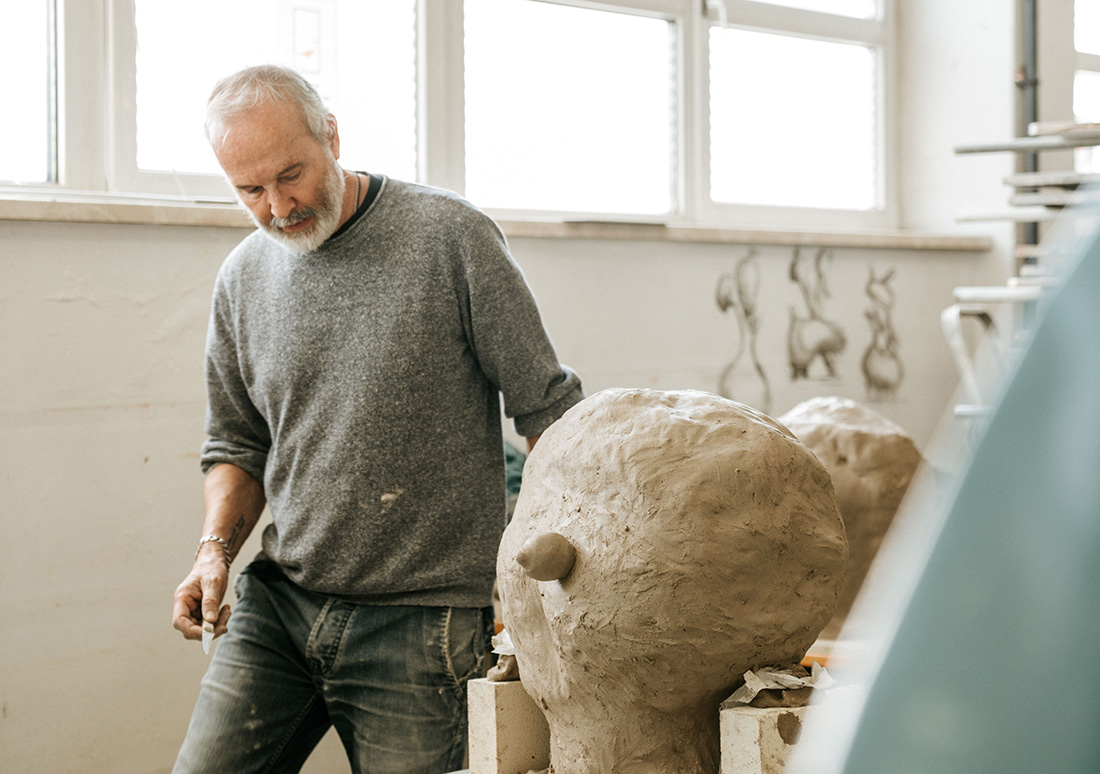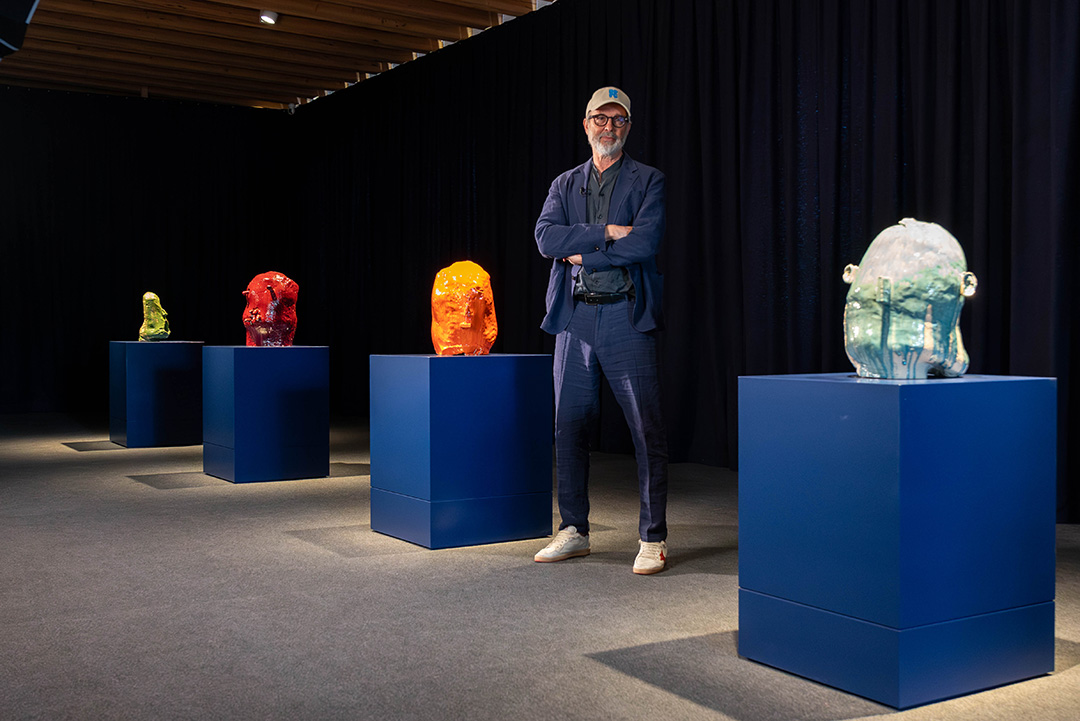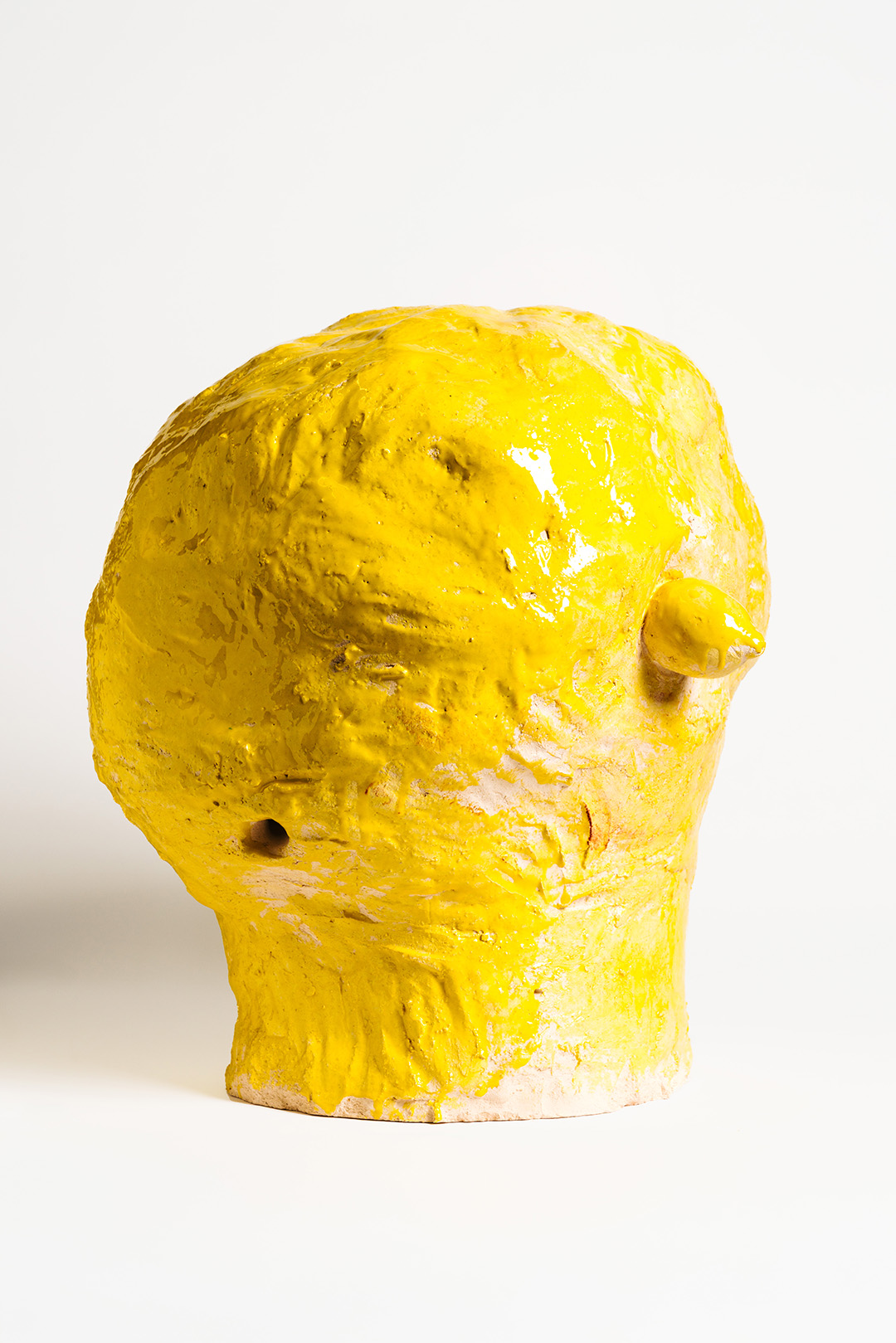




Erwin Wurm is considered Austria's most important contemporary artist. His works have been exhibited in the world's most renowned museums and galleries, including the Museum of Modern Art (MoMA) in New York and the Tate Modern in London. He has now created a new series of sculptures: "Bad People" was created in collaboration with the Academy of Ceramics Gmunden (AoCG) and can now be seen at the Gmundner Keramik Manufaktur. The exhibition is the latest project of the AoCG as a platform for artists, which was launched in 2022 by Gmundner together with OÖ Landes-Kultur GmbH. The focus is on the exchange between Europe's oldest ceramics manufactory and artists of international standing - most recently with the Chinese artist Ai Weiwei, for example.
In this interview, Erwin Wurm talks about faces and heads, clay as a design medium and why it sometimes helps to look through the lens of the absurd.
Mr Wurm, for your new ceramic sculptures you have created paradoxical representations of people: distorted noses, ears, mouths and faces. What was your idea behind this and why are we dealing with "bad people"?
At the centre of these new works are primarily ideas of people - or more precisely: of heads. I experiment with the prototype of the head, a mostly round, voluminous form, punctuated by openings. Eyes, ears, nose, mouth - these characteristic elements form the starting point. Often supplemented by a neck, they are re-contextualised, distorted and deformed by me. This sometimes results in physiognomic echoes, but sometimes also abstract shapes that defy clear categorisation. It is a game of perception and expectation: what exactly characterises a head? What seems familiar to us, what seems strange - and what might even be grotesque? I am not pursuing concrete portraits or specific depictions of individual people. And yet the work is aimed at something deeply human. Are the results really "bad people"? I'm not entirely sure myself. The title served more as a vague, associative framework. The actual creative process, on the other hand, was open, playful and in constant motion.
You used ceramics as a means of artistic expression. What characterises clay as a creative medium for you?
When you work with clay, something quite amazing happens: you go back to the beginning of sculpting. Putting both hands in the clay really fascinated me. To feel how it sticks softly between your fingers, how you can use it to build up volume, add and subtract again. In this way, elementary sculptural principles can be explored - in a constant interplay between intellect and manual activity. Sometimes the head directs the movement of the hands, sometimes the hands take the lead and the head tries to follow. It was a highly interesting process that is difficult to describe and took me away from the usual processes of my artistic work. There, it is usually about realising concrete ideas and concepts in materials, including the challenges that this entails. Working with clay, on the other hand, brought something else to the fore: an immediacy, directness, often experimental, guided solely by the material itself. You suddenly find yourself back where you started as a child: back in the sandpit, where figures, fantasies and shapes were created from wet sand. That is ultimately what I have done here: I went back to the beginning and played.
Were there any particular role models or influences that were important to you when working with ceramics and clay?
I actually wanted to take a rather unorthodox or perhaps even naive approach to these things. In other words, I wanted to mould something with the clay that you wouldn't normally do with it. Although, of course, there is always the possibility of unconsciously placing yourself in an artistic continuity. I don't know myself, and that's the beauty of it. However, one thing has probably already influenced me in my work ...
What exactly are you thinking about?
Most recently, I've been working a lot on early artefacts, i.e. the way in which our ancestors expressed themselves. The tools they used alone have something incredibly urgent and unconditional about them - hand axes or bone needles, for example. One understands: This is where the beginnings are, this is where man first begins to create. That was also what fascinated me so much while working on "Bad People": this return to clay - archaic, elemental, almost childlike.
What role did the craftsmanship aspect play in this process? You realised your project at the Gmundner Keramik Manufaktur.
Let's put it this way: as far as the craftsmanship was concerned, it was only important to me personally that what I created could withstand the high temperature of the firing. And without any details being broken or lost. For this to work smoothly, you need experience, care - and support. In my case, this came from the great people on site at Gmundner Keramik, who accompanied and supported me with their knowledge. Working with clay is a time-consuming process. After I developed my sculptures, everything had to be dried first. Only then did the next step begin: glazing. This involves applying a diluted colour powder that melts during firing and covers the entire object like a film. Only when this process is complete do the objects take on their actual, correct colour. The colour tone is therefore completely different when it is applied. That was often irritating when I was painting. In a way, I had to think like a photo negative. This always resulted in a moment of uncertainty: whether everything would work as I had imagined.
"Bad People" picks up on a characteristic element of their art: they deform elements of our everyday life - houses, for example, or cars - and thus enable a new perspective on them. Many people find that funny. Do you too?
There's a certain misunderstanding here: I don't operate with humour. I'm not a joke teller or comedian. What interests me is the paradoxical and the absurd. Adding or reducing volume, for example, can change content and shift levels of meaning. In this way, sculpture can be used to pose questions about our present. And in particular to what immediately surrounds us, be it houses, cars, gherkins - or heads and faces. Something familiar that we encounter in a different form may seem funny at first. But I'm always interested in the moment that follows: The irritation that can lead us to question what we take for granted as part of our reality. I think when you look through the lens of the absurd, you often see the world more clearly.
The interview was conducted by Manuel Weißhaar GeSK, Agency for Public Relations.



